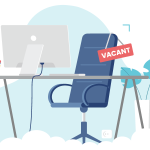Why are employers losing the talent war?
May 9, 2022

Employers are facing one of the worst talent shortages in years. A growing skills gap, changing workforce demographic, and a broader reevaluation of the role work plays in our lives has culminated in a hiring race that has empowered workers to be more selective than ever when it comes to employment.

The pressure is on. But in the battle for talent, employers have proven to be their own worst enemy. While some are struggling to keep up with market changes, others are simply unwilling to accept this new power dynamic, clinging to old hiring habits that end up backfiring and spiking turnover.
The tried-and-true recruitment strategies of years past simply won’t cut it anymore. In order to stay competitive, employers will have to look closer at the issues affecting hiring success and tailor their approach to fit a job seekers market. To help you out, we’ve outlined some key considerations for talent attraction: why the market’s shifted, what employers are doing wrong, and what you can do about it.
Disclaimer: Please note that the information provided herein is presented from a liability-based perspective to help you avoid insurance claims. It is not exhaustive and does not constitute legal, employment, or insurance advice, nor will it apply to all workplaces, employers, employees, situations, or circumstances. For tailored advice, please consult a recruitment, talent acquisition, or human resources specialist.
Labour Market Trends: Why are we experiencing talent shortages?
The Great Resignation has dominated headlines for quite some time now. And while there’s debate over whether Canada has faced the same levels of turnover as the US—a record 4.5 million Americans quit their jobs in March—we’re still experiencing widespread talent shortages, with vacancies in the skilled trades, healthcare, retail, hospitality, and travel sectors.
But the Great Resignation is just the tip of the iceberg. The truth is: the pandemic has only amplified existing shortages in Canada’s labour market—and they’re poised to get worse. Here’s why:
1. Aging Population
An aging population has cut down our workforce by about a million since 2008/09. Even worse? Canada’s labour force participation rate will continue to drop as baby boomers inch towards retirement age in the next 5-10 years. In fact, about 23% of the working age population will be 65 years or older by 2024, removing roughly 600,000 people from our workforce over the next three years.
2. Skills Shortage
Skilled workers are in short supply, with knowledge-based industries like STEM, manufacturing, healthcare, and finance hit hard. As aging workers retire, businesses are having a tough time finding people with specialized qualifications to replace them. Job tasks are also changing rapidly as more technology is incorporated into workflows, far outpacing what our training and production systems can keep up with.
To make matters worse, immigration backlogs during the pandemic delayed the addition of skilled groups into Canada’s workforce. And while the government is planning to welcome over 432,000 immigrants this year as part of Canada’s plan to fill labour gaps, it will be some time before the market rebounds.
3. Shifting Employee Attitudes
After years of burnout and working too hard for too little, employees are finally pushing back. They want better work-life-balance. They want more flexible schedules, remote work options, and benefits plans. They want to be appreciated for their skills and contributions. And above all, they want to feel valued.
According to a study by Canadian staffing firm Robert Half, roughly 40% of millennials aged 25 to 40 intend to look for a new job in the first half of 2022. 19% said they’d quit their jobs without having another one lined up. And even though the rate of resignations will likely slow down at some point, it’s not likely that employee expectations will change.
For these reasons, many have argued that the Great Resignation is really more of a Great Reckoning. Or a Great Redefinition. Or a Great Reflection. But whatever we’re calling it, there’s no question that employee attitudes have changed.
RELATED: Work, Sleep, Eat, Repeat: Managing the Burnout Crisis
4. Career Switching
While some workers were laid off or saw reduced hours during the pandemic, others faced heavy workloads from organizational disruptions, workplace maladjustments, or lower staff capacities. These challenges, combined with added stressors brought on by the pandemic, have compounded feelings of burnout and led to structural changes in the labour market. As a result, many have switched careers, gone into self-employment, or left the workforce altogether.
RELATED: 8 Frequently Asked Questions About Home-Based Businesses
5. The Talent War
The tables have turned. Unlike the recession where we had more workers than available jobs, now there aren’t enough workers, much less skilled workers, to satisfy the needs of the job market, a dynamic that has effectively put employees in the driver’s seat. With a bevy of options before them, qualified candidates in high-demand fields like engineering, software development, and nursing have more bargaining power than ever to secure higher pay and better working conditions—and they’re not willing to settle anymore.
Business Challenges: What are employers doing wrong?
Experts anticipate these hiring challenges to last for at least five years, until baby boomers have retired and the labour market stabilizes. Until then, employers will need to prepare themselves for a wave of organic resignations over the next few years to replace workers that have shifted passions, moved away, reshuffled their life priorities, or left the workforce altogether.
But despite notable changes in the labour market, most organizations haven’t fully adapted their hiring practices yet, with many scrambling to fill spots without consideration for the needs of today’s candidates or even their own workforce. Common pitfalls include:
1. Overlooking Demographic Changes
Employers will have to pivot their recruiting strategies to stand out as an employer of choice for younger professionals as Generation Z (those born between 1997 and 2012) joins the workforce. Unlike older millennials whose renewed focus on work-life balance may have been triggered by the pandemic, Gen Z’ers are entering the labour market looking for meaning and purpose in their job. They want to feel invested in the work they do from the start and they want potential employers to integrate well into their lives.
Research also suggests that newer generations are more socially conscious in their career choices and have strong stances on issues like sustainability, diversity, equity, and inclusion, and more. And if they don’t find what they’re looking for, they’re also more willing to wait for the right fit and find a supportive employer whose values align with their own worldview.
Adjusting to this mindset, or even acknowledging these shifts, might be challenging for organizations who may not have historically prized criteria like culture, benefits and perks, or corporate social responsibility.
RELATED: Back to Normal? Helping Employees Prepare for Work After the Pandemic
2. Poor Wellness Benefits
Pre-pandemic, it was easy to reel candidates in with perks like company socials, free lunches, or a ping pong table. In the age of remote work, many organizations have moved towards salary, stock options, and signing bonuses as hiring incentives. But compensation is only half of the equation. Now more than ever, employees want benefits that support their health, life goals, and overall well-being.
Unfortunately, while larger companies are making headlines for offering caregiver stipends, extra vacation time, gym memberships, and more, SMBs might not have the budget or bandwidth to implement robust wellness initiatives. Many of them don’t offer benefits plans at all, even though there are affordable options out there (and dedicated risk advisors to help them secure the right program for their needs).
But without additional incentives, SMBs don’t stand a chance against their larger counterparts in a job seekers market. Benefits programs tell prospects a lot about your company—how much you value your staff, what you expect of them, and what the work culture is like. And if employees don’t feel like you care or support them in their whole lives, they’ll take their talents to greener pastures.
RELATED: How can group benefits help my small business?
3. Limited Resources
Employers aren’t just dealing with a skills shortage in the labour market; they’re also facing them internally. Companies hit hard by the pandemic or small businesses who don’t have a talent acquisition team—or even HR for that matter—might not have the time, resources, or personnel to properly understand or address people-related risks.
Burnout is also a concern here. In addition to achieving hiring objectives, recruiters, talent acquisition specialists, and HR professionals have had to adjust to major changes like virtual interviewing and onboarding over the last few years. They’re running on fumes and may not have the energy to attract the right kinds of candidates or sufficiently train them.
Alternatively, recruiters might be so backlogged or overrun with tasks that the hiring process becomes long and drawn out, and good candidates are poached away in the meantime. Reports show that almost three-quarters (72%) of professionals say they lose interest in a job if they don’t hear back within 10 business days after the initial interview. If there’s no update after three weeks, that figure shoots up to 87%.
4. Need For Speed
With turnover rates so high, hiring managers are in a frenzy to fill vacant positions, regardless of whether or not someone is necessarily the right fit for a role. Technical competencies, qualifications, and even robust background checks might go out the window if it means someone can start tomorrow.
According to a recent survey commissioned by Express Employment Professionals, over a quarter of Canadian companies (26%) have hired people they normally wouldn’t have to combat talent shortages. Many have dropped job requirements, with nearly half (45%) overlooking experience, 37% forgoing hard skills, and 20% loosening up on education.
In their desperation, some employers might even cut corners in the hiring process to get someone working right away, resulting in a failure to properly vet candidates, evaluate their skills, or onboard them.
5. Lack of Senior Engagement
On the other hand, in companies with dedicated recruitment teams, business leaders might take a more hands off approach and leave the hiring up to HR entirely. In the Mercer Marsh Benefits 2021 The Five Pillars of People Risk Report, the majority of organizations (37%) viewed talent attraction and retention as an HR problem. 20% felt the executive leadership team should be responsible for managing this risk and only a shocking 1.5% felt there should be “no single responsibility” for talent management.
With minimal involvement, that means some senior leaders might be unaware of the challenges HR teams are facing, while others might not be providing enough clarity about their talent needs. This disconnect may exert undue pressure on HR professionals and contribute to bad hiring practices, where recruiters feel rushed to fill a good position or don’t know how to identify a “bad hire” for a particular position.
What’s the impact?
Employers who don’t adapt to these new workplace realities will fall behind the competition and lose out on the talent they need to grow their businesses. Even worse? Taking shortcuts in the hiring process could have the unintended effect of increasing your overall business liability.
After all, a company is only as good as its people and even one quick fix hire could have a cascading impact throughout your entire organization that results in lost time and productivity, reputational harm, and legal action. Bad hires can also cause team disruptions, destroy workplace morale, and increase turnover if organizations fail to respond and other team members are left dealing with the fallout by themselves, compounding the talent shortages you had to begin with.
Ultimately, unless businesses recognize human capital as a key tenet of risk management—one that demands the time, resources, and attention as any other business risk—they won’t just lose the talent war; they’ll curb any potential for long-term growth.
RELATED: How much will a bad hire really cost your business?
What can employers do?
In order to secure not just the best talent, but the right talent for their business needs, employers will have to think long-term. They’ll need to get inside the mind of today’s candidate and work proactively to meet their needs. They’ll need to take a more holistic approach to wellness and beef up their benefits plans. And finally, they’ll need a solid talent acquisition strategy to boost hiring outcomes and mitigate the liability risks of a bad hire.
RELATED: Talent Attraction Strategies in a Job Seeker’s Market
Don’t know where to start? Connect with PROLINK to learn more. As a licensed broker with over 40 years of experience, we can help you make sense of the shifts in the labour market and what they mean for your business, regardless of your company’s size, trade, or workforce. Our dedicated advisors will help you:
- Identify and assess your risks so you can make informed decisions about talent attraction;
- Align your organization with specialized risk management, insurance, and group benefits solutions that will reduce your exposures and boost hiring outcomes; and
- Continuously monitor your plans so they evolve to meet your needs long-term while keeping costs predictable.
Connect with PROLINK today to learn more!
PROLINK’s blog posts are general in nature. They do not take into account your personal objectives or financial situation and are not a substitute for professional advice. The specific terms of your policy will always apply. We bear no responsibility for the accuracy, legality, or timeliness of any external content.




